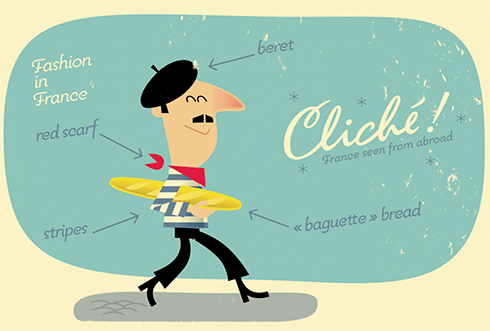An image that would caracterize a culture, a country / An example what is Britishness !
As we were in class we started this intertaining research in our memory about what elements could correspond to the British culture. Food, sports, places, objects and other things quite stereotypical, such as the nickname ''roast beefs'' given apparently by French people towards British people (I admit I had no idea XD), also refering to the British custom which is originally to eat roast beef on Sunday (or from what I heard recently, because their skin tan under the sun rays would be quite red XD) . Well I mean we also have a nickname ''frogs'' as we French people would apparently eat frogs legs or something like that, well I mean if there are and there are I'm pretty sure of that XD Let's not make a generality, even though Stereotypes are generally genuinely like that. I mean as long as it makes no harm and picture some funny ideas as the image of France seen wearing a beret with a stripes shirt and a red scarf, holding a loaf of bread, casually growing a mustache XD. Or to comeback with the main subject here, the picture of British people well-mannered as gentlemen holding an umbrella (if you watched kingsman for example XD) and yet on the other hand also holding a beer, the ball right at their feet in true hooligans to support their team.
But well I am not really here to talk about the overall clichés up to a country or another but about the reflexion we had to do, about choosing a picture that would sum up quite well the idea of Britishness. Maybe I will do the same for the French culture next time calling it ''the Frenchness'' ;).
Basically I think I got inspired towards the guard side since the beginning of the class, looking for symbolic objects and the bearskin hat came in mind. So even though I did not pick the example of the foot guards with the hat, guarding the Buckingham Palace for the Queen, I kept my focus on the guards and picked the first picture you can see above this article, with the beefeater guards. Let's see why /
This picture was taken before a telephone box. In general at the top of it, instead of the beefeater badge, there is a carving of the crown with the monarchs initials underneath. Also seen on postboxes, what we can see is VR (Victoria Regina in latin, thus meaning Queen Victoria) or olders with GR (Georgeus Rex meaning King Georges). It is one of the symbols on the street that allow the stereotype of old fashion in Britishness.
Next obviously, we can state in the middle the guard's presence, standing right in front of the telephone box. Those guards are the one at the tower of London, also called yeoman warders. In principles, their role on basis was and is to look after the prisoners at the Town and on top of that safeguarding the British crown jewels. But in practice they act as tour guide and find themselves being a tourists attraction in their own right. Their nickname is beefeater which we could link with the nickname given to British people as roast beefs. Apparently beefeater would have appeared from the time when the Yeomen Warders at the tower were paid part of their salary with chunks of beef, until up in the 1800s. I also picked this picture as the Yeomen of the guard is the oldest of the royal bodyguards and the oldest military corps in existence in Britain. More precisely the Yeomen Warders were formed in 1509 by Henry VIII, when he decided one day to leave behind twelve of his Yeomen that were sick to watch out the Tower. And the Yeomen of the guard in 1485, after his victory at the battle of Bosworth, Henry VII gathered a group of soldiers together to become his personal bodyguard and to accompany him wherever he went.
Furthermore, both Yeomen Warders and Yeomen of the guard are wearing the very famous scarlet and gold state dress uniform which date from 1552. Of course there is a little something to distinguish the two of them, as the Yeomen of the guard are wearing their cross belts from the left shoulder. As we can pick out here, the front of their chest is full of British symbols such as /
The rose (floral symbol of England), the shamrock (plant symbol of Ireland), and the thistle (floral symbol of Scotland) altogether in conjunction. This floral badge symbolizes the peace and the end of the war, plus the union between Britain and Ireland with the incorporation of the shamrock into the Royal Coat of Arms of the United Kingdom since the Acts of 1800s, thus a symbol of history still remaining today in Ireland and to the Queen's side in London.
The last picture is an extract of a Newspaper and I found it quite interesting to see the picture used showing a civilized yet serious but humorous pose of a British civilian, one of the pictures we genuinely have when thinking about the word Britishness ^^. Furthermore the article from the end of the twentieth century is quite interesting, describing the point of view of someone who entered the life of Britain but was not a native, upon the British culture. I'll post what says the article later on, as we cannot see very clearly what is written underneath the headline. Have a nice day !

/image%2F2141698%2F20160918%2Fob_0212ec_asian-art-thinkstock.jpg)








/https%3A%2F%2Fassets.over-blog.com%2Ft%2Fcedistic%2Fcamera.png)
/image%2F2141698%2F20180512%2Fob_e08170_526888-gatebox-virtual-home-robot.jpg)
/https%3A%2F%2Fi.ytimg.com%2Fvi%2FniBM3Ii662U%2Fhqdefault.jpg)
/image%2F2141698%2F20180120%2Fob_345170_self-portrait-by-edward-hopper.jpg)
/image%2F2141698%2F20160908%2Fob_6e8ff9_alice-in-wonderland-animals-art-cats-f.jpg)